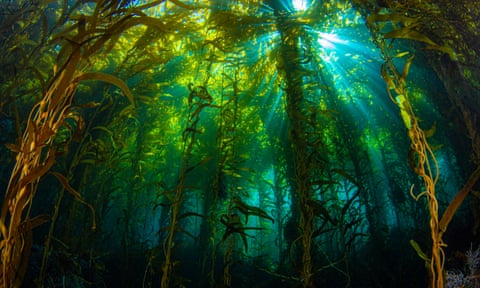Bubbles stream furiously behind Frank Hurd as he gently parts the curtains of giant kelp. Green and gold ribbons reach upwards through the cold waters of the Pacific Ocean towards the sun.
Hurd, a marine biologist with environmental organisation the Nature Conservancy, is diving in a kelp forest off Anacapa Island, one of the protected rocky volcanic islets that form the Channel Islands national park, an archipelago off the coast of southern California.
This thick, healthy kelp – a type of seaweed – forms a small part of underwater forests that blanket the coastline of nearly every continent. Some are relatively well-studied, including the Great African Sea Forest, a rich stretch of giant bamboo kelp spreading north from Cape Town to the Namibian coastline that was the setting for the film My Octopus Teacher; and the Great Southern Reef, a giant kelp forest hugging Australia’s southern coastline. But many more of these forests are unnamed and unknown – hidden underwater.
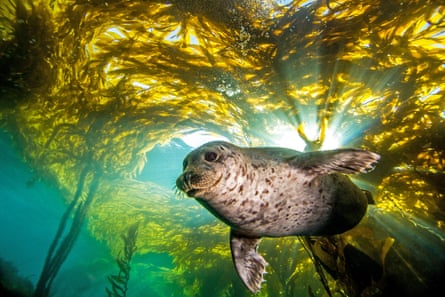
Despite being one of the fastest growing plants on Earth, kelp has historically been difficult to map because of the difficulties of measuring ocean depths with satellites. However, research published in September found that seaweed forests are far more extensive than previously realised.
An international group of scientists from eight countries, led by Dr Albert Pessarrodona from the University of Western Australia, manually sifted through hundreds of studies – including local plant data records, online repositories and citizen science initiatives – to model the global distribution of ocean forests. They found that underwater forests cover between 6m and 7.2m sq km – an area comparable to the Amazon rainforest basin and twice the size of India.
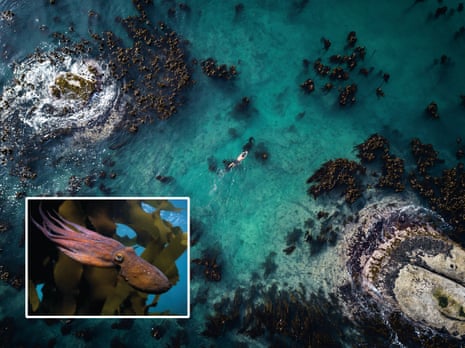
Seaweed forests can act as a vital buffer against the climate crisis, absorbing carbon dioxide from seawater and the atmosphere. Ocean forests may store as much carbon as the Amazon rainforest, according to one analysis.
Yet there is still a sizeable gap in understanding of seaweed’s long-term ability to sequester carbon, because it lacks a root system to lock the carbon into the ground, unlike other marine plants such as mangroves and seagrass. Whether carbon stays locked up also depends on what happens to the seaweed, and there is still scientific debate on how effective it is at storing the element.
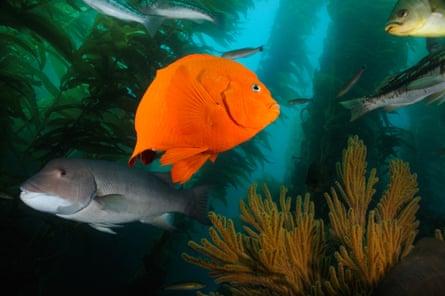
Marine ecologist Dr Karen Filbee-Dexter, one of the study’s 10 authors, said the research was a “major step forward” in understanding the potential role that seaweed can play in mitigating climate breakdown, “because it calculates the productivity – growth and carbon uptake – of the largest marine vegetated ecosystem”. It can also help estimate the carbon-sink potential of the world’s marine forests, she added.
Kelp, the largest seaweed species, able to grow tens of metres high, also plays a vital role in marine ecosystems, providing food and shelter for fish, other marine animals and birds.
In Australia, native kelp is home to the weedy seadragon – a purple-hued creature with leaf-like appendages that look like kelp fronds – which only lives along the country’s coastline. Kelp forests along North America’s Pacific coast provide vital habitats for southern sea otters. In addition, the mighty grey whale uses kelp forests as a haven from predatory killer whales and as vital feeding grounds for their young during their migration to Alaska waters from Baja California in Mexico.
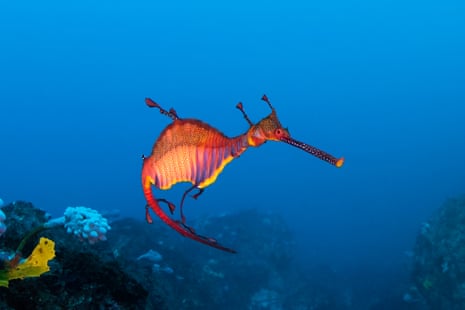
Underwater forests could also have a role in efforts to alleviate the world’s food security crisis, thanks to their rapid growth.
The scientists examined hundreds of individual studies from around the world where seaweed growth had been measured by scuba divers. “We found ocean forests are more productive than many intensely farmed crops such as wheat, rice and corn,” the study noted. It defined productivity in terms of how much biomass – the fronds, stipes and holdfasts of the seaweed – was produced by crops and seaweed.
On average, ocean forests in temperate regions, such as Australia’s southern coast, produced between two and 11 times more biomass by area than intensely farmed crops, a productivity that could be harnessed for the food system.
Seaweed has been mass-consumed in Asia for centuries, and now western markets are catching on, albeit on a small scale, with more European and North American companies manufacturing seaweed products for human consumption. The Cornish Seaweed Company has a seaweed salad range; Marks & Spencer has a “coconut seaweed crunch” snack, and there are numerous lines of kelp burgers.
“Although there is evidence of seaweed being consumed as food 14,500 years ago, it has not been a part of the diet for large swaths of the world’s population,” says marine biologist Amanda Swinimer, who has been wild harvesting seaweed for decades through her company, Dakini Tidal Wilds.
However, she adds, as food security becomes more of an issue, “people are looking for other sources of nutritious food. If harvested properly, seaweeds have the potential to be a very sustainable and nutrient-dense food source.” Seaweed is also being used as animal feed, in place of corn and soya beans, thanks to its high nutritional value.

Yet these underwater forests face multiple threats, including rising sea temperatures, pollution and invasive species. Along the northern California coast, kelp has declined by more than 95% over the past several years, decimated by sea urchins – whose population has exploded as vast numbers of starfish, their main predators, have been killed by a wasting disease linked to warming waters.
The Great Southern Reef along Australia’s coastline, and forests in the north-west Atlantic, along the coasts of Maine, Canada and Greenland, are also showing concerning signs of decline.
Seaweed forests are often overlooked and less studied compared with coral reefs, making it difficult to understand how they are changing. “Most of the world’s seaweed forests are not even mapped, much less monitored,” says Filbee-Dexter. While corals are found in warm, calm and easily accessible areas, making them fairly easy to study, kelp is in cold waters on some of the choppiest, roughest coasts in the world.
Filbee-Dexter believes that the more scientists understand about these vital but fragile marine ecosystems, the easier it will be to help them survive. “I hope that more awareness about these forests will lead to more protection and restoration.”
In California, Hurd continues to dive among the kelp forests, monitoring their progress and hoping their decline can be stemmed. “The loss of these incredibly productive ecosystems is devastating for both nature and people,” he says. However, as science continues to develop smarter technologies to track kelp, such as drones, satellites and AI, he remains hopeful that research can shed light on the role of kelp in fighting climate breakdown.
“The one thing that kelp in particular should never be underestimated for is the productivity and biodiversity it supports around the world. It should be protected and restored with a great sense of urgency.”

